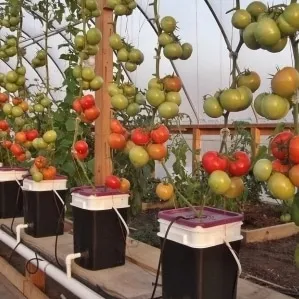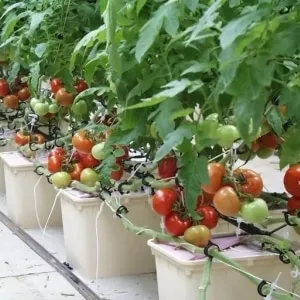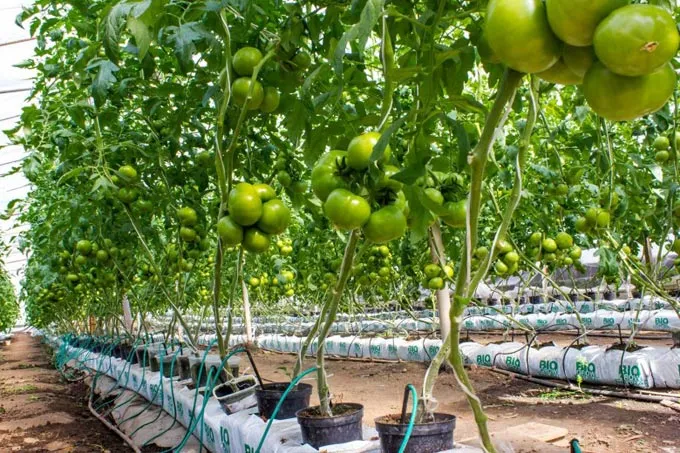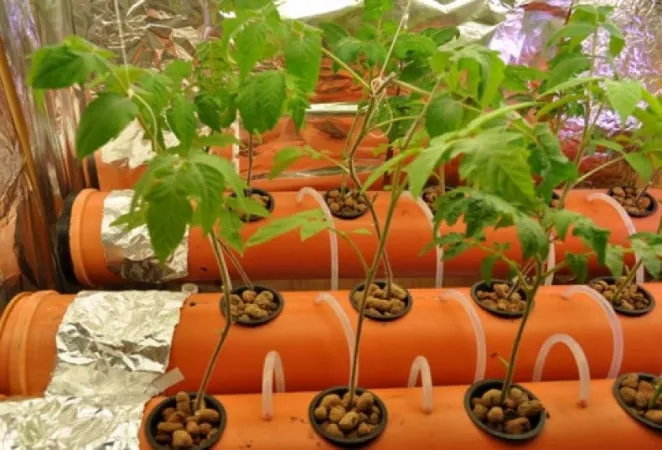Freshly picked vegetables from the garden are incomparable to store-bought ones. But what if you want to grow plants but don’t have a garden or a plot of land? Hydroponics is the answer. With hydroponics, you can grow tomatoes, cucumbers, and other vegetables right at home.
In this article, you’ll learn everything a beginner gardener needs to know: how to grow plants hydroponically, which nutrient solution to choose, the ideal temperature, and how to assemble your own hydroponic system.
Table of contents
What Is Hydroponics?
Hydroponics is a technology that allows growing vegetables without soil. The roots are nourished by special nutrient mixes and solutions. This method requires frequent watering and feeding.
Hydroponics is also used for growing tomatoes. These vegetables are low-maintenance, so you can harvest them year-round. The technology is suitable for both industrial-scale farming and home use. Even beginner gardeners can master this method.
Advantages of Hydroponics
 Cost-efficiency is the main benefit of hydroponics. There’s no need for watering, fertilizing, or weeding. Space is used optimally.
Cost-efficiency is the main benefit of hydroponics. There’s no need for watering, fertilizing, or weeding. Space is used optimally.
Other advantages include:
- efficient nutrient absorption by plants;
- faster growth;
- better control over plant development;
- higher yield;
- organic, pesticide-free produce.
Disadvantages of Hydroponics
The drawbacks include the initial cost of equipment and materials. Not all gardeners can easily set up a hydroponic system at home, so it’s essential to study the method thoroughly first.
This growing method doesn’t protect plants from diseases and pests. An improperly prepared nutrient solution can damage roots, cause flowers to drop, and deform fruits.
Best Tomato Varieties for Hydroponics
Experts say that nearly all tomato varieties can be grown hydroponically. However, experienced gardeners have found that greenhouse and early-maturing types work best.
- Gardener’s Delight — a disease-resistant variety. Requires staking during growth. Fruit weight: 80-100 g, with up to 5 kg per plant.
- Alaska — matures in 55-70 days. Yield: 3-3.5 kg per plant.
- Sweetie F1 — disease-resistant, starts fruiting in 55-70 days. Yield: 3.5-4 kg per plant.
- Tiny Tim — doesn’t require pruning or staking, resistant to blight. Matures in 45-60 days, fruit weight: ~50 g.
- Cherry tomatoes: Super Sweet 100 and Improved Red Cherry varieties.
What You Need to Grow Tomatoes Hydroponically
Successful hydroponic growing requires substrate, pots of different sizes, an EC meter, and a hydroponic system.
The substrate must be rinsed and disinfected before use. Options include fine gravel, crushed stone, slag, moss, expanded clay, mineral wool, coconut coir, or coarse sand.
For hydroponics, 10-12 cm pots work best. They should have a fluid level indicator. Fill the pots with substrate, then place them in larger containers with the nutrient solution. One plant needs about 10 liters of substrate.
An EC meter helps measure the nutrient solution concentration.

Hydroponic systems come in two types:
- Active — uses pumps;
- Passive — no mechanical parts.
The system may use drip irrigation, nutrient film technique (NFT), or ebb and flow. If there’s no pump for root irrigation, an aquarium pump can be used instead.
How to Grow Tomatoes Hydroponically
Tomato seeds are sown for seedlings in late spring or early summer. In winter, lighting costs will increase.
Follow these steps when sowing seeds:
- Soak seeds in a 1% potassium permanganate solution for 15 minutes.
- Rinse thoroughly.
- Place seeds in specialized plugs or nutrient-soaked sponges/cotton.
- Water every 2-3 days.
- After a week, lay the sprouts on their side.
- After another week, transplant into specialized cubes.
- Three weeks later, place the well-moistened cubes in a disinfected tray.
- The plants are now ready for transplanting into the hydroponic system.
Note! Each seedling requires 0.9-1.2 m² of space.
Temperature
On sunny days, the temperature should not exceed +24 °C — otherwise, flowers may drop. The exception is the fruiting stage, where temperatures can be 4 °C higher.
At night, temperatures shouldn’t fall below +16 °C, as this slows root activity, negatively affecting growth and yield. The substrate temperature should be around +20 °C.
Root System Control
To ensure a good harvest, monitor root growth. Periodically remove small pots from the solution. Once roots emerge from the pot’s drainage holes, reduce the nutrient solution level to create an air gap of 4-8 cm.
Lighting
Tomatoes need ample light. If natural light is insufficient, use fluorescent or UV lamps. Red light alone can sterilize flowers, while a mix of blue and red light promotes fruit set and growth.
During growth, tomatoes need up to 20 hours of intense light; during fruiting, up to 17 hours.
Hydroponic Nutrient Solutions
Special hydroponic solutions can be bought or made at home by dissolving complex fertilizers in water. However, an incorrect mix can harm plants. An overly concentrated solution burns roots, while a weak one reduces yield.
Different growth stages require different nutrient compositions. The pH should stay between 6.0-6.3. Potassium hydroxide can raise pH, while phosphoric acid lowers it.
Check the solution’s concentration daily with an EC meter. Ideal readings are 1.5-3.0 mS. Adjust by either replacing the solution or adding nutrients.
Note! Replace the nutrient solution every 3-4 weeks.
Staking and Care
Some tomato varieties need staking. Do this once the stem reaches 20 cm — even for dwarf varieties.
Pollination is part of the process. Use a soft brush to transfer pollen between flowers. To encourage upward growth, prune side shoots.
Hydroponic Tomato Growing Methods
Hydroponic tomato cultivation relies on three methods: aeroponics (air-based), water culture, and substrate-based (nutrient film technique).
Aeroponics
Plants are fixed with clamps, leaving one-third of the roots in the substrate. The remaining roots in the air gap are misted regularly with nutrient solution. A repurposed humidifier can simplify spraying.
Water Culture
Uses a foam tray placed in a water-filled container. Small holes are made for plant stems. Once placed in the tray, stems must be secured.
An air pump can oxygenate the water. However, this system isn’t ideal for tomatoes due to high humidity.

Substrate Method
Roots grow in a substrate like moss or gravel, periodically soaked in nutrient solution. Excess liquid must be drained to prevent rot. Similar to traditional greenhouse growing.
How to Build Your Own Hydroponic System
A hydroponic system for tomatoes includes pumps, irrigation and aeration systems, plant containers, and a timer-controlled compressor for topsoil irrigation.
You’ll need:
- 140 cm PVC pipe (10 cm diameter);
- 2 end caps;
- pipe connector;
- 10 cm pots;
- aquarium air pump;
- 2 air stones;
- timer;
- connecting tubes.

Drill holes in the pipe for pots. Attach an end cap on one side and a connector with a cap for the pump on the other. Install linear air stones inside, connected via tubes to the pump. Fill the system with water and place the pots.
Conclusion
Hydroponics is ideal for urban living. City dwellers can grow tomatoes, cucumbers, and more year-round. The benefits outweigh the drawbacks.
You can also save money by building the system yourself from simple components. The result? Delicious, homegrown tomatoes from your balcony or windowsill.







